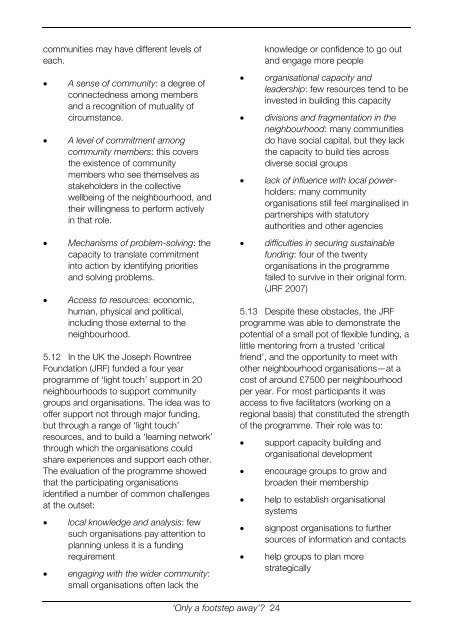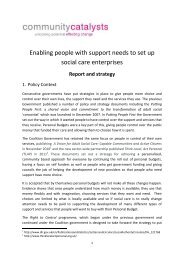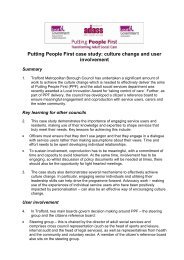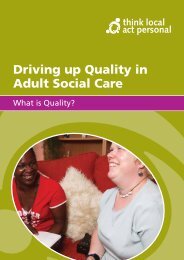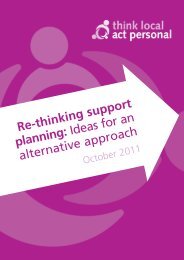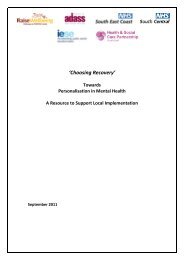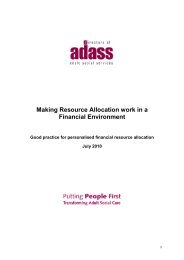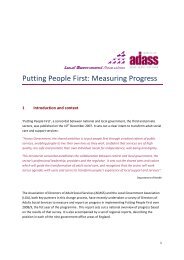communities may have different levels ofeach.• A sense of community: a degree ofconnectedness among membersand a recognition of mutuality ofcircumstance.• A level of commitment amongcommunity members: this coversthe existence of communitymembers who see themselves asstakeholders in the collectivewellbeing of the neighbourhood, andtheir willingness to per<strong>for</strong>m activelyin that role.• Mechanisms of problem-solving: thecapacity to translate commitmentinto action by identifying prioritiesand solving problems.• Access to resources: economic,human, physical and political,including those external to theneighbourhood.5.12 In the UK the Joseph RowntreeFoundation (JRF) funded a four yearprogramme of ‘light touch’ support in 20neighbourhoods to support communitygroups and organisations. The idea was tooffer support not through major funding,but through a range of ‘light touch’resources, and to build a ‘learning network’through which the organisations couldshare experiences and support each other.The evaluation of the programme showedthat the participating organisationsidentified a number of common challengesat the outset:• local knowledge and analysis: fewsuch organisations pay attention toplanning unless it is a fundingrequirement• engaging with the wider community:small organisations often lack theknowledge or confidence to go outand engage more people• organisational capacity andleadership: few resources tend to beinvested in building this capacity• divisions and fragmentation in theneighbourhood: many communitiesdo have social capital, but they lackthe capacity to build ties acrossdiverse social groups• lack of influence with local powerholders:many communityorganisations still feel marginalised inpartnerships with statutoryauthorities and other agencies• difficulties in securing sustainablefunding: four of the twentyorganisations in the programmefailed to survive in their original <strong>for</strong>m.(JRF 2007)5.13 Despite these obstacles, the JRFprogramme was able to demonstrate thepotential of a small pot of flexible funding, alittle mentoring from a trusted ‘criticalfriend’, and the opportunity to meet withother neighbourhood organisations—at acost of around £7500 per neighbourhoodper year. For most participants it wasaccess to five facilitators (working on aregional basis) that constituted the strengthof the programme. Their role was to:• support capacity building andorganisational development• encourage groups to grow andbroaden their membership• help to establish organisationalsystems• signpost organisations to furthersources of in<strong>for</strong>mation and contacts• help groups to plan morestrategically‘Only a <strong>footstep</strong> away’? 24
• operate variously as mentor, criticalfriend, mediator and independentbroker as required.5.14 The role of the facilitator in the JRFprogramme is not dissimilar from thetraditional role of community developmentworkers, though the latter have more of afocus upon linking people in theirneighbourhoods with the wider planningstructures where there is the power to shiftresources or reshape how services aredelivered. Although the traditional specialistrole of ‘community development worker’ isnow less common, the role continues inspecialist niches and services such asneighbourhood management, communityarts, health promotion initiatives, anti-drugcampaigns, youth work and Sure Start.5.15 The 2007/8 Citizenship Surveypublished by DCLG (2009b) finds someevidence of self-reported involvement involunteering, but the figures are not brokendown on a small area basis. The surveyreports that 27% of people in England saythey participated in <strong>for</strong>mal volunteering atleast once a month, and 35% claim tohave participated in ‘in<strong>for</strong>malvolunteering’—in both cases a 3% fall onthe position recorded in 2005. Thosepeople classified as at risk of socialexclusion were less likely to regularlyparticipate. The more recent 2008-09survey reveals little change in theserespects (DCLG 2010c). Fewer than half ofthe people surveyed said that they wouldlike to be more involved in decisionsaffecting their local area, but people whofelt strongly that they belonged to theirneighbourhood were more likely than thosewho did not have such strong feelings toparticipate in civic engagement.5.16 The evaluation of theNeighbourhood Management Pathfinders(DCLG 2008e) was able to report somesuccess in widening communityengagement, beyond a handful of peoplein the early stages to a strong core of 20–60 involved in deliberative processes suchas board membership and contributing toworking groups. This was complementedby the more limited involvement of largernumbers of local residents in networks,<strong>for</strong>ums and consultation exercises. A studyof Pathfinder board membership found it tobe broadly representative of the localpopulation in terms of age, gender andethnicity, though engaging young peoplewas more challenging.5.17 The recently published nationalevaluation of participatory budgeting offersevidence on the use of a small ‘communitychest’ (averaging around £2000) to engagesmall communities in decision-making(DCLG 2010d). The interim evaluationreports improvements along severaldimensions, including: self-esteem andconfidence; people’s sense of their abilityto influence local decision-making; andlocal ‘community capacity’, especiallywhen linked to wider communitydevelopment or neighbourhoodmanagement initiatives. A kindred initiativeis Community Cashback, which (in2010/11) will be repeated to enablecommunities to decide how to spend therecovered proceeds of criminal activity intheir neighbourhoods.5.18 The 2008 Place Survey published byDCLG (2008a) reported that while 80% ofpeople said they were happy with theirarea, only 45% were satisfied with the waythe local council was per<strong>for</strong>ming. Partly inresponse to this, the <strong>Local</strong> Democracy,Economic Development and Construction<strong>Act</strong> 2009 lays a new duty on councils torespond to petitions, and to tell localpeople what action is going to be taken toaddress their concerns. Guidance coversexamples of the responses councils shouldconsider in four key areas: underper<strong>for</strong>mingschools, alcohol-related crime‘Only a <strong>footstep</strong> away’? 25


